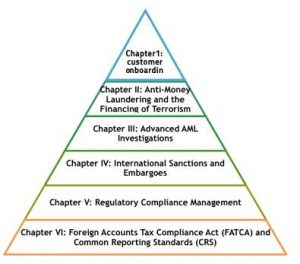|
The Certified Compliance Manager (CCM) curriculum is acomprehensive one that cover topics like KYC, AML/CFT, FATCA & CRS and Compliance.
The curriculum includes Six (6) Chapters as below:

Below are the detailed outlines for each chapter:
Course Introduction and Objectives
Chapter I: Customer Onboarding and KYC
- Identification of Individual Accounts
- Personal Affirmation Document
- Address
- Work and Income Information
- Purpose of Account Opening
- Authorized Signatories
- Queries
- Requirements for Identification of Corporate Accounts
- Charities and Non-Profit Organizations
- Embassies and Government Agency Accounts
- Accounts of Minors
- Accounts by Power of Attorney or Bank Authorizations
- Identify the Real Beneficiary of the Account
- KYC Customer Identification Form
- First: Customer Information
- Second: Address (Residence Indicator)
- Third: Work and Income Information
- Fourth: Account Management Information
- Fifth: Inquire About Politically Exposed Person PEP
- Sixth: Telephone Number
- Seventh: Inquiry about (FATCA)
- Eighth: Customer Signature
- Quick Tips
- A Design for KYC form (individuals)
- Know your customer entity form (companies)
- Identify Owners and Natural Shareholders
- Identify the Authorized Signatories of the Company
- Information of (FATCA) in Know Your Customer Form
- KYC Form Design for Companies
- General Terms and Conditions
- European Data Protection Act (General Data Protection Regulation – GDPR)
- Accept Instructions by Fax or Email
- (W 9) form
- W8BEN Form
- W8BEN-E Form
- Opening (Non–Face-to-Face) Account
- Incomplete Accounts
- Modify the Customer Data
- Customer Risk Rating
- First: Customer Type
- Second: Geographical
- Third: Products, Services, and Deliver- Channels
- KYC Update
- Online KYC Update
- Opening Accounts for People with Disabilities (Heroes)
- General Rules and Guidelines
- Dormant Accounts
- Closure of Accounts
- Processes of Account Opening
- Account Opening Through Branches
- Accounts Activation Through Central Management
- Best Practices for Account Opening Mechanisms
- Digital Identity and Electronic Know Your Customer (EKYC)
Chapter II: Anti-Money Laundering and the Financing of Terrorism
- The Concept of Money Laundering
- Elements of the Concept of Money Laundering
- Original Crime
- Financial or Physical Returns from the Original Crime
- Camouflage and Concealment
- Knowledge of the Sources of Funds
- The Stages of Money Laundering
- The First Stage: Placement
- The second stage: Layering
- The third stage: Integration
- Terrorist financing
- The Difference between Money Laundering and the Financing of Terrorism
- The Consequences of Money Laundering and Terrorism Financing Crimes
- Cash Deposits
- Suspicious Customer Behavior
- Bank Accounts
- Wire Transfers
- Safety Deposit Boxes
- Credit Facilities
- Trade Financing and Letter of Credit (Import and Export)
- Electronic Banking Services
- Customer behavior
- Foreign Letter of Guarantee
- Insurance Companies
- Fuel Stations, Restaurants and Business Activities with Intensive Cash
- Casinos
- Real Estate Trading
- Shell Companies
- Virtual Currencies
Chapter III: Advanced AML Investigations
- Payable Through Accounts – PTA
- Nesting and Downstreaming
- Internal Accounts
- Unusual Transaction
- Transactions Monitoring
- Alert-Investigations (Case Management)
- Confidentiality of Suspicious Activity Reports
- Summary of FATF Recommendations
- Factors of Successful Compliance and AML Program
- Independence and Appropriate Location within the Institution Structure
- Qualified Team
- Automatic Systems and Keeping Abreast of Technological Development
- Mind and Way of Thinking for AML Manager
- Policies and Procedures
- Continuous Training and Keeping Abreast of Developments
- Independent Audit
- Money Laundering Risk Classification
- First: Customer Type
- Second: Geographical Factor
- Third: Product and Service and Delivery Channels Factor
- Types of Money Laundering Risk Classification
- Prohibited
- High-Risk
- Medium-Risk
- Low-Risk
- Electronic AML Risk Rating
- Risk Assessment of Correspondent Banks
- AML Risk-Based Approach
- First: Inherent-Risks Classifications
- Second: Set Weight for Each Inherent-Risk classifications
- Third: Identify the impact of non-compliance on each type of risk
- Fourth: The Weighting of Each Impact on the Inherent Risks
- Fifth: Identifying controls (Risk Mitigation)
- Sixth: Determining the Level of Compliance
- Seventh: Set Weight of Each Risk-Mitigation
- Eighth: Determining the Level of Compliance in Each Risk-Mitigation
- Ninth: Giving Weight to Each Compliance Level
- Summary of Inherent Risk Calculation, Risk Mitigation, and Residual Risk
- Determine the Date of the Next Examination
Chapter IV: International Sanctions and Embargoes
- Introduction
- Definition of Sanctions
- The Importance of Imposing Sanctions.
- Processes
- Account Opening
- Banking Authenticated Messages
- Other Products and Services
- Case Study and Other-Advices to the Specialist
- Dealing with High-Risk Countries
- Systems
- Computer Assisted Audit Techniques (CAATs)
- System Internal Lists
- General Sanctions Software Highlights
- Violation Report – Structure:
- Violation Report – Interpreting the Results:
- Interpreting Bank Authenticated Messages Report
- Conclusion
- United Nations
- United States Initiatives
- US Patriot Act
- OFAC Sanctions Against Sudan
Chapter V: Regulatory Compliance Management
- The Scope
- Compliance to Direct Regulatory Bodies Instructions
- Compliance with Internal Policies in the Institution
- Department
- Relationship of the Compliance Department with the Chief Executive Officer
- (CEO)
- The Relationship of the Compliance Department with the Board of Directors And its Committees
- Compliance Policy
- The Scope and Purpose of the Policy
- Tasks of The Institution’s Staff Regarding Compliance
- Communication with Regulatory Bodies
- Compliance Monitoring and Examination Process
- First: Monitoring Simple Requests
- Second: The Monitoring of Periodic Reporting to Regulators
- Third: Compliance Role in Work Procedures and provide advices
- Fourth: The Compliance Monitoring of Regulatory Requirement
- Risk-Based Approach in Compliance Examination
- First: Inherent-Risks Classifications:
- Second: Set Weight for Each Inherent-Risk classifications
- Third: Identify the impact of non-compliance on each type of risk
- Fourth: The Weighting of Each Impact on the Inherent Risks
- Fifth: Identifying controls (Risk Mitigation)
- Sixth: Determining the Level of Compliance
- Seventh: Set Weight of Each Risk-Mitigation
- Eighth: Determining the Level of Compliance in Each Risk-Mitigation
- Ninth: Giving Weight to Each Compliance Level
- Summary of Inherent Risk Calculation, Risk Mitigation, and Residual Risk
- Determine the Date of the Next Examination
- Issuing Regulatory Compliance Reports
Chapter VI: Foreign Accounts Tax Compliance Act (FATCA) and Common Reporting Standards (CRS)
- Definition of FATCA
- Types of FATCA Agreements
- Risk of Non-Compliance with FATCA
- Material Breach
- Event of Default
- Consequences of Non-Participation of Financial Institutions in FATCA
- Definition of a US Person (subject to FATCA)
- FATCA Responsible Officer
- Tax Evasion Practices
- How to Deal with the Pre-Existing Accounts (four projects)
- First: Individual Accounts Indicators
- Second: Indicators of the Corporate Accounts
- Third: High-Value Accounts
- Fourth: Accounts of Financial Institutions
- Documents Required for Accounts Subject to the Law
- W-8BEN Form
- Form W9
- Form W8-BEN-E
- Joint Accounts
- Minors Accounts
- Power of Attorney
- Employee’s Accounts
- Recalcitrant Accounts
- Annual reporting
- The Date of Reporting
- Date of Balance
- Individual Accounts
- Corporate Accounts
- Pooled Reporting
- Reporting of Closed Accounts
- Reporting Mechanism
- Common Reporting Standards (CRS)
- Overview of CCM exam
Wrap Up
|




